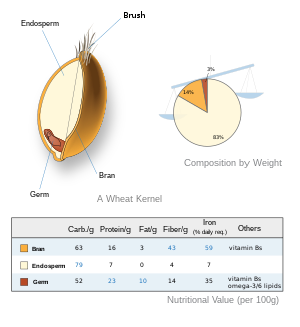**Whole Grain Composition and Health Benefits:**
– Whole grains contain endosperm, germ, and bran, providing carbohydrates, nutrients, and fiber.
– Consumption of whole grains is associated with lower risk of heart disease, cancer, and type 2 diabetes.
– Whole grains improve micronutrient intake and are recommended for children and adults.
– They are rich in fiber, vitamins, minerals, and antioxidants, promoting digestive health and weight management.
– Whole grains have a lower glycemic index compared to refined grains, contributing to overall health and well-being.
**Gluten Concerns and Alternatives:**
– Gluten can trigger coeliac disease, affecting about 1% of the population in developed countries.
– Non-coeliac gluten sensitivity is another gluten-related disorder.
– Minor cereals and pseudocereals are gluten-free alternatives for those with gluten-related disorders.
– The only effective treatment for coeliac disease is a lifelong gluten-free diet.
– Gluten-containing grains like wheat, barley, rye, and oats are to be avoided by individuals with gluten-related disorders.
**Regulations and Labeling:**
– In the US, wholegrain product identification is based on the ingredients list, ensuring significant whole grain content.
– Different grains and pseudocereals can be labeled as whole grains.
– Regulations allow up to 5% of the kernel to be removed from whole-wheat flour.
– In the UK, the term ‘wholemeal’ is legally protected, with voluntary guidelines for labeling wholegrain products.
– Specific criteria and guidelines by regulatory bodies ensure accurate labeling of whole grain products.
**Whole Grain Consumption Recommendations:**
– National guidelines recommend consuming at least half of grains as whole grains for overall health.
– Menu planners are encouraged to incorporate a variety of whole grain-rich foods in school meal programs.
– Health organizations stress the importance of whole grains in a balanced diet.
– Consuming a variety of whole grains ensures diverse nutrient intake and supports overall well-being.
– Different countries have specific criteria for labeling products as whole grain, promoting healthy dietary habits.
**Whole Grains, Nutrition, and Disease Risk:**
– Whole grains are linked to reduced cardiovascular disease, type 2 diabetes, and certain cancer risks.
– Studies show lower mortality rates and improved weight management with whole grain consumption.
– Including whole grains in the diet improves health and well-being.
– The fiber and antioxidants in whole grains contribute to their health benefits.
– Health organizations recommend whole grains as part of a balanced diet for overall health.
A whole grain is a grain of any cereal and pseudocereal that contains the endosperm, germ, and bran, in contrast to refined grains, which retain only the endosperm.[dead link][dead link]

As part of a general healthy diet, consumption of whole grains is associated with lower risk of several diseases. Whole grains are a source of carbohydrates, multiple nutrients and dietary fiber.
